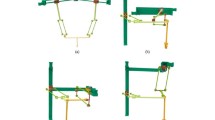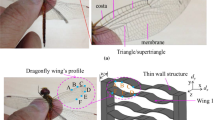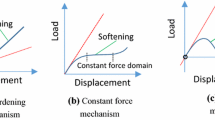Abstract
Compliant translational joints (CTJs) have been extensively used in precision engineering and microelectromechanical systems (MEMS). There is an increasing need for designing higher-performance CTJs. This paper deals with the conceptual design of CTJs via three approaches: parallelogram based method, straight-line motion mechanism based method and combination based method. Typical emerging CTJ designs are reviewed by explaining their design principles and qualitatively analyzing their characteristics. New CTJs are proposed using three approaches, including an asymmetric double parallelogram mechanism with slaving mechanism, several compact and symmetric double parallelogram mechanisms with slaving mechanisms and a general CTJ using the center drift compensation and a CTJ using Roberts linkage and several combination designs. This paper provides an overview of the current advances/progresses of CTJ designs and lays the foundation for further optimization, quantitative analysis and characteristic comparisons.
Similar content being viewed by others
References
Howell L L. Compliant Mechanisms. New York: John Wiley & Sons, 2001
Howell L L, Magleby S P, Olsen B M. Handbook of Compliant Mechanisms. New York: John Wiley & Sons, 2013
Trease B P, Moon Y M, Kota S. Design of large-displacement compliant joints. Journal of Mechanical Design, 2005, 127(4): 788–798
Mackay A B, Smith D G, Magleby S P, et al. Metrics for evaluation and design of large-displacement linear-motion compliant mechanisms. Journal of Mechanical Design, 2012, 134(1): 011008
Olfatnia M, Cui L, Chopra P, et al. Large range dual-axis micro-stage driven by electrostatic comb-drive actuators. Journal of Micromechanics and Microengineering, 2013, 23(10): 105008
Olfatnia M, Sood S, Gorman J, et al. Large stroke electrostatic comb-drive actuators enabled by a novel flexure mechanism. Journal of Microelectromechanical Systems, 2013, 22(2): 483–494
Olfatnia M, Sood S, Awtar S. Note: An asymmetric flexure mechanism for comb-drive actuators. Review of Scientific Instruments, 2012, 83(11): 116105
Yong Y K, Moheimani S O R, Kenton B J, et al. Invited review article: High-speed flexure-guided nanopositioning: Mechanical design and control issues. Review of Scientific Instruments, 2012, 83(12): 121101
Hiemstra D B, Parmar G, Awtar S. Performance tradeoffs posed by moving magnet actuators in flexure-based nanopositioning. IEEE/ASME Transactions on Mechatronics, 2012, 19(1): 201–212
Hao G, Meng Q, Li Y. Design of large-range XY compliant parallel manipulators based on parasitic motion compensation. In: Proceedings of the ASME 2013 International Design Engineering Technical Conferences & Computers and Information in Engineering Conference. Portland, 2013
Genequand P M U S. Patent, 6059481, 2000-05-09
Brouwer D M, Otten A, Engelen J B C, et al. Long-range elastic guidance mechanisms for electrostatic comb-drive actuators. In: Proceedings of the 10th International Conference of the European Society for Precision Engineering & Nanotechnology. Delft, 2010, 47–50
Zhao H Z, Bi S S, Yu J J, et al. Design of a family of ultra-precision linear motion mechanisms. Journal of Mechanisms and Robotics, 2012, 4(4): 041012
Zhao H Z, Bi S S, Yu J J. A novel compliant linear-motion mechanism based on parasitic motion compensation. Mechanism and Machine Theory, 2012, 50: 15–28
Hubbard N B, Wittwer J W, Kennedy J A L, et al. A novel fully compliant planar linear-motion mechanism. In: Proceedings of the 2004 ASME Design Engineering Technical Conferences. Salt Lake City, 2004
Pei X, Yu J, Zong G, Bi S. Design of compliant straight-line mechanisms using flexural joints. Chinese Journal of Mechanical Engineering, 2014, 27(1): 146–153
Beroz J D, Awtar S, Bedewy M, et al. Compliant microgripper with parallel straight-line jaw trajectory for nanostructure manipulation. In: Proceedings of 26th American Society of Precision Engineering Annual Meeting. Denver, 2011
Hopkins J B, Panas R M. A family of flexures that eliminate underconstraint in nested large-stroke flexure systems. In: Proceedings of the 13th Euspen International Conference. Berlin, 2013
Zhao H Z, Bi S S. Accuracy characteristics of the generalized crossspring pivot. Mechanism and Machine Theory, 2010, 45(10): 1434–1448
Hao G, Kong X, He X. A planar reconfigurable linear rigid-body motion linkage with two operation modes. Proceedings of the Institution of Mechanical Engineers. Part C, Journal of Mechanical Engineering Science, 2014, 228(16): 2985–2991
Kong X, Gosselin C M. Type Synthesis of Parallel Mechanisms. Berlin: Springer, 2007
Author information
Authors and Affiliations
Corresponding author
Rights and permissions
About this article
Cite this article
Hao, G., Li, H., He, X. et al. Conceptual design of compliant translational joints for high-precision applications. Front. Mech. Eng. 9, 331–343 (2014). https://doi.org/10.1007/s11465-014-0321-y
Received:
Accepted:
Published:
Issue Date:
DOI: https://doi.org/10.1007/s11465-014-0321-y




